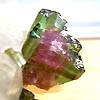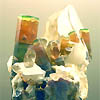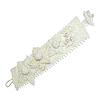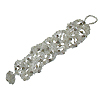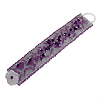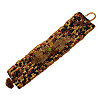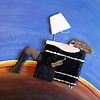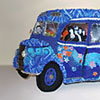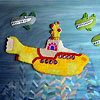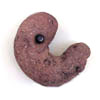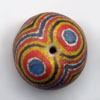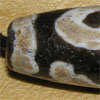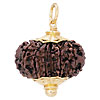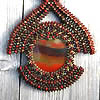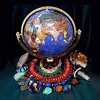October, 2008

From MyLovelyBeads.com TeamIn a week, we will celebrate Halloween, that includes trick-or-treating, ghost tours, bonfires, costume parties, visiting "haunted houses" and so on. Happy Halloween! But, take your time and read in our October issue:
Tourmaline group
Contact us with any questions at
info@mylovelybeads.com.
New on MyLovelyBeads.com Beading as contemporary art Ethnic beads Art of reflection November upcoming events Best regards,
MyLovelyBeads.com Team |
Tourmaline groupTourmaline is a fascinating mineral (to be exact, group of minerals) that can actually exhibit two or more colors in one crystal. It possesses one of the widest color ranges, reproducing every conceivable color in the universe, it's another gemstone of October (you can read about the first gem - opal in our last year's October issue). The name "tourmaline" comes from the Singhalese word TURAMALI or TORAMALLI, meaning "stone attracting ash" (a reference to its pyroelectric properties) or according to other sources "mixed gemstones". For a while the name "tourmaline" was applied to different gemstones found in Ceylon (now Sri Lanka). Brightly colored tourmalines were brought to Europe from Sri Lanka in great quantities by the Dutch East India Company to satisfy a demand for curiosities and gems. At that time the gem schorl that looks like tourmaline was known in Europe, but it was not realized that both stones belong to the same mineral group. The most common species of tourmaline is schorl. It may account for 95% or more of all tourmaline in nature. The early history of the mineral schorl shows that the name "schorl" was in use prior to 1400 AD because a village, that had a nearby tin mine where black tourmaline was found, known today as Zschorlau (in Saxony, Germany) was then named "Schorl" (or minor variants of this name). As it was said, tourmaline has a variety of colors. Usually, tourmalines are black to bluish-black to deep brown, brown to yellow, blue, green, red, yellow, pink etc. Rarely, it is colorless. Bi-colored and multicolored crystals are common, reflecting variations of fluid chemistry during crystallization. Crystals may be green at one end and pink at the other, or green on the outside and pink inside: this type is called watermelon tourmaline. Some forms of tourmaline are dichroic, in that they change color when viewed from different directions. Gem and specimen tourmaline is mined chiefly in Brazil and Africa. Some placer material suitable for gem use comes from Sri Lanka. In addition to Brazil, tourmaline is mined in Tanzania, Nigeria, Kenya, Madagascar, Mozambique, Namibia, Afghanistan, Pakistan, and Sri Lanka, and Malawi. Some fine gem and specimen material has been produced in the US, with the first discoveries in 1822, in the state of Maine (raspberry pink-red as well as minty greens tourmaline). California became a large producer of tourmaline in the early 1900s (bright pinks, as well as bicolors). Tourmaline species and varieties 1. Dravite species: from the Drave district of Carinthia (Austria)
• dravite - dark yellow to brownish black
2. Schorl species:
• schorl - bluish or brownish black to black
3. Elbaite species: named after the island of Elba, Italy
• rubellite - rose or pink (from ruby)
• indicolite - dark blue (from indigo) • "Brazilian sapphire" - light blue • "Brazilian emerald" or verdelite - green • achroite - colorless (from the Greek word for "colorless") Tourmaline facts 1. The Empress Dowager Tz'u Hsi, the last Empress of China, loved pink tourmaline and bought large quantities for gemstones and carvings from the then new Himalaya Mine, located in San Diego County, California. 2. Native Americans have used pink and green tourmaline as funeral gifts for centuries. |
|
Recently madeNew bracelets designed and made by Zoya Gutina: they are different in style, different in color, different in materials. You can buy them on MyLovelyBeads.com or contact us to discuss your needs with us. We love to design for specific individuals, incorporating their energy and personality into the piece. Many of the spectacular pieces you can see on the site are the result of a custom order that undoubtedly inspired a higher level of creativity. For those of you, who hasn't read our last issues: we have added a few new articles to our jewelry making section on MyLovelyBeads.com: |
|
Featured artistIf you make search in Wikipedia by the word "beader", it will suggest you a few definitions, one of them says, "A beader uses beads to create many kinds of decorative items." Don't try to find in encyclopedia who The Lone Beader is. To start, we will tell you, that The Lone Beader is an extraordinary bead embroidery artist. Would you like to know some more? OK, The Lone Beader tells you her story on beads, bead embroidery, and beading as contemporary art. "I have always been involved in the arts ever since I can remember. During elementary school in Erie, PA, I loved both art and music class, but I had a strong preference for music. I learned how to play the viola and I was very active in music all through my childhood. Music was my #1 priority, but I had other interests, as well. I loved coloring and painting. My younger sister and I were always doing something creative. I remember that we made a lot of beaded necklaces and collages, but I think we tried almost every kind of craft at least once. My mother was always telling me I should try drawing, but I never thought I could, so she showed me how to cross-stitch. I remember spending hours outside under a tree working on my needlecraft. My father also influenced me in a much different way. He loved racing cars and flying airplanes, and was always taking me with him on his journeys. Because of him, I had great big dreams of becoming an astronaut, fighter pilot, or roller coaster engineer. But instead, I decided to study music in Boston. During college, I began working in the theatre, setting up rock concerts for a living. While I have worked other jobs, this was the only one that has interested me enough to stick with for well over a decade - perhaps it is because this career's infrequent schedule has given me the opportunity to rediscover the arts. It never occurred to me to pursue a visual art until about 6 years ago. One day, I walked into a bead shop in Boston, and when I saw all of the seed beads, I felt like I finally found what I had been searching for. So, I started reading books and magazines and teaching myself how to make complex jewelry designs in almost every technique. But, when I tried bead embroidery, I knew this was what I loved most. The idea for my first bead painting came after I embroidered a 6" x 9" panel depicting a flock of flamingos. I needed a way to display the finished piece, so I stitched the beaded panel to a canvas and painted in the extended environment. It was a simple concept, but I really liked the result, so I sent in a photo to Bead & Button Magazine. They published Flamingo Moon in 2005. That publication eventually led to my first commission, which was an experience that helped me find my artistic path, and has driven me to follow it..."
Full story by The Lone Beader
|
|
Ethnic beadsMagatama beads - are curved beads which first appeared in Japan during the Jomon period and then spread to the Asian continent through Korean peninsula. They are often found inhumed in mounded tumulus graves (a tumulus is a mound of earth and stones raised over a grave or graves) as offerings to deities. They continued to be popular with the ruling elites throughout the Kofun Period of Japan, and are often romanticized as indicative of the Yamato Dynasty of Japan. They are mainly made of jade, agate, quartz, talc, and jasper. Some consider them to be an Imperial symbol, although in fact ownership was widespread throughout all the chieftainships of Kofun Period Japan. It is believed that magatama were popularly worn as jewels for decoration, in addition to their religious meanings. Kiffa beads - are rare powder glass beads named after the Mauritanian city of Kiffa, where French ethnologist R.Mauny documented them first in 1949. Kiffa beads represent one of the highest levels of artistic skill and ingenuity in beadmaking, being manufactured with the simplest materials and tools available - pulverized European glass beads or fragments of them, bottle glass, pottery shards, tin cans, twigs, steel needles, some gum arabic, and open fires. Glass which is finely crushed to a powder is mixed with a binder such as saliva or gum arabic diluted in water. Decorations are made from the glass slurry i.e. crushed glass mixed with a binder and applied with a pointed tool, usually a steel needle. The beads are placed in small containers, often sardine cans and heated to fuse the glass on open fires without moulds. Dzi beads - is a bead stone of mysterious origin worn with a necklace and sometimes bracelet. Collectively in almost all Asian cultures, the bead are expected to provide positive spiritual benefit and sometimes used in traditional Tibetan medicine, when a portion of the bead has been scraped or shaved away to be ground into the medicine. Beads that are broken are believed to have diluted benefit because they have taken the brunt of the force that would have otherwise impacted the wearer. Dzi stones are made from agate, and may have decorated symbols composed of circles, ovals, square, waves (zig zags), stripes, lines, diamonds, and other patterns. Colors will mainly range from browns to blacks with the pattern usually being in ivory white. Dzi beads can appear in different colors, shapes and sizes. The number of "eyes" on the stone usually signify different meanings. Rudraksha - is the name of the dark berries, used to make prayer beads. The Rudraksha tree is a large evergreen broad-leaved tree that grows in the area from the Gangetic Plain to the foothills of the Himalayas. Rudraksha trees are also found in middle areas of Nepal. Rudraksha seeds are covered by an outer shell of blue color when fully ripe, and for this reason are also known as blueberry beads. Rudraksha beads are the material from which sacred garlands - japa malas or malas (108 beads in number, though other numbers, usually divisible by 9, are also used) are made. Malas are used by Hindus and Buddhists for keeping count while reciting, chanting, or mentally repeating a mantra or the name or names of a deity. We told you just about four types of ethnic beads... |
|
Art of reflection
Our another featured artist this month is an experienced beader and teacher. Natasha Machikhina has been beading for more than ten years since getting started while studying at the Moscow Pedagogical University. She saw some beadwork that a friend was wearing and decided that she would take classes to learn beadwork techniques. She learned through the classes as well as reading books on the subject. She quickly began to create her own designs often inspired by nature and using gemstone cabochons and big beads. Natasha usually begins creating a new piece based on the cabochon shape and color. Her goal is to transform a mess of beads into a piece of jewelry which reflects her impressions while also using her work to express her moods. Natasha also used other media as an artist living in the Moscow region. She is an artist by nature and likes oil painting, encaustic painting (hot wax painting), graphics, pastel crayon, watercolor and photography. Different media help her to use her work to better express herself. In the Spring of 2008 she participated in the 2nd exhibition "Modern bead design" in Moscow, where she displayed her jewelry collection made using her favorite square rope technique. Natasha believes, that square ropes are flexible, hard and soft at the same time, and that technique allows her to design her very unusually shaped jewelry. She now owns a website which she calls "Art of Reflection", where she displays much of her different media artwork. We hope you will enjoy her artwork as much as we do.
Art of reflection. Jewelry by Natasha Machikhina
|
|
Upcoming events
November - December, 2008 The exhibit features pieces made by the winning artists from the Bead Museum's 1st Annual International Juried Jewelry Design Competition Celebrating Beads, the journey of... 21st Annual Washington Craft Show
November 7,8,9, 2008 A premier national event of contemporary American craft, the Washington Craft Show transforms DC's Convention Center into a showcase for 190 leading craft artists and their latest work from 34 states and DC. Celebrating its 21st year, this major fall show includes 41 new artists among established and emerging talent selected by jury to present their signature collections for home and to wear. Each piece is one-of-a-kind or limited edition, made with vision and mastery. |
|
NoteIf you don't see the newsletter properly formatted please click here: October Issue |
© 2010 MyLovelyBeads.com All Rights Reserved.
If you do not want receive our newsletter and you wish to remove your email address from our mailing list, please click the following link to unsubscribe.



